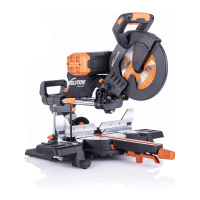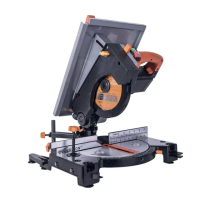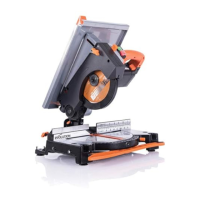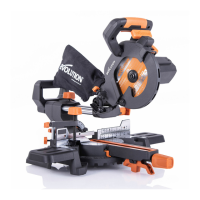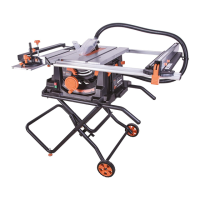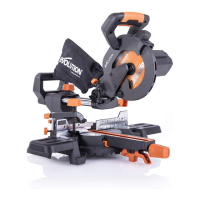workpiece. The riving knife is ineffective when cutting workpieces
that are too short to be engaged with the riving knife. Under these
conditions, a kickback cannot be prevented by the riving knife.
• Use the appropriate saw blade for the riving knife. For the
riving knife to function properly, the saw blade diameter must
match the appropriate riving knife and the body of the saw blade
must be thinner than the thickness of the riving knife and the
cutting width of the saw blade must be wider than the thickness
of the riving knife.
2) Cutting procedures warnings
• DANGER: Never place your fingers or hands in the vicinity
or in line with the saw blade. A moment of inattention or a slip
could direct your hand towards the saw blade and result in serious
personal injury.
• Feed the workpiece into the saw blade only against the
direction of rotation. Feeding the workpiece in the same
direction that the saw blade is rotating above the table may result
in the workpiece, and your hand, being pulled into the saw blade.
• Never use the mitre gauge to feed the workpiece when
ripping and do not use the rip fence as a length stop when
cross cutting with the mitre gauge. Guiding the workpiece with
the rip fence and the mitre gauge at the same time increases the
likelihood of saw blade binding and kickback.
• When ripping, always apply the workpiece feeding force
between the fence and the saw blade. Use a push stick when
the distance between the fence and the saw blade is less
than 150mm, and use a push block when this distance is less
than 50mm. “Work helping” devices will keep your hand at a safe
distance from the saw blade.
• Use only the push stick provided by the manufacturer or
constructed in accordance with the instructions. This push stick
provides sufficient distance of the hand from the saw blade.
• Never use a damaged or cut push stick. A damaged push stick
may break causing your hand to slip into the saw blade.
• Do not perform any operation “freehand”. Always use either
the rip fence or the mitre gauge to position and guide the
workpiece. “Freehand” means using your hands to support or
guide the workpiece, in lieu of a rip fence or mitre gauge. Freehand
sawing leads to misalignment, binding and kickback.
• Never reach around or over a rotating saw blade. Reaching for
a workpiece may lead to accidental contact with the moving saw
blade.
• Provide auxiliary workpiece support to the rear and/or sides
of the saw table for long and/or wide workpieces to keep them
level. A long and/or wide workpiece has a tendency to pivot on
the table’s edge, causing loss of control, saw blade binding and
kickback.
• Feed workpiece at an even pace. Do not bend or twist the
workpiece. If jamming occurs, turn the tool off immediately,
unplug the tool then clear the jam. Jamming the saw blade by
the workpiece can cause kickback or stall the motor.
• Do not remove pieces of cut-off material while the saw is
running. The material may become trapped between the fence or
inside the saw blade guard and the saw blade pulling your fingers
into the saw blade. Turn the saw off and wait until the saw blade
stops before removing material.
• Use an auxiliary fence in contact with the table top when
ripping workpieces less than 2mm thick. A thin workpiece may
wedge under the rip fence and create a kickback.
3) Kickback causes and related warnings
Kickback is a sudden reaction of the workpiece due to a pinched,
jammed saw blade or misaligned line of cut in the workpiece with
respect to the saw blade or when a part of the workpiece binds
between the saw blade and the rip fence or other xed object.
Most frequently during kickback, the workpiece is lifted from the
table by the rear portion of the saw blade and is propelled towards
the operator.
Kickback is the result of saw misuse and/or incorrect operating
procedures or conditions and can be avoided by taking proper
precautions as given below.
• Never stand directly in line with the saw blade. Always position
your body on the same side of the saw blade as the fence.
Kickback may propel the workpiece at high velocity towards
anyone standing in front and in line with the saw blade.
• Never reach over or in back of the saw blade to pull or to
support the workpiece. Accidental contact with the saw blade
may occur or kickback may drag your fingers into the saw blade.
• Never hold and press the workpiece that is being cut off
against the rotating saw blade. Pressing the workpiece being
cut off against the saw blade will create a binding condition and
kickback.
• Align the fence to be parallel with the saw blade. A misaligned
fence will pinch the workpiece against the saw blade and create
kickback.
• Use a featherboard to guide the workpiece against the table
and fence when making non-through cuts such as rabbeting.
A featherboard helps to control the workpiece in the event of a
kickback.
• Use extra caution when making a cut into blind areas of
assembled workpieces. The protruding saw blade may cut
objects that can cause kickback.
• Support large panels to minimise the risk of saw blade
pinching and kickback. Large panels tend to sag under their own
weight. Support(s) must be placed under all portions of the panel
overhanging the table top.
• Use extra caution when cutting a workpiece that is twisted,
knotted, warped or does not have a straight edge to guide it
with a mitre gauge or along the fence. A warped, knotted, or
twisted workpiece is unstable and causes misalignment of the kerf
with the saw blade, binding and kickback.
• Never cut more than one workpiece, stacked vertically or
horizontally. The saw blade could pick up one or more pieces and
cause kickback.
• When restarting the saw with the saw blade in the workpiece,
centre the saw blade in the kerf so that the saw teeth are not
engaged in the material. If the saw blade binds, it may lift up the
workpiece and cause kickback when the saw is restarted.
• Keep saw blades clean, sharp, and with sufficient set. Never
use warped saw blades or saw blades with cracked or broken
teeth. Sharp and properly set saw blades minimise binding,
stalling and kickback.
4) Table saw operating procedure warnings
• Turn off the table saw and disconnect the power cord when
removing the table insert, changing the saw blade or making
adjustments to the riving knife or saw blade guard, and when
the machine is left unattended. Precautionary measures will
avoid accidents.
• Never leave the table saw running unattended. Turn it off
and don’t leave the tool until it comes to a complete stop. An
unattended running saw is an uncontrolled hazard.
• Locate the table saw in a well-lit and level area where you can
maintain good footing and balance. It should be installed in
an area that provides enough room to easily handle the size of
your workpiece. Cramped, dark areas, and uneven slippery floors
invite accidents.
• Frequently clean and remove sawdust from under the saw
table and/or the dust collection device. Accumulated sawdust is
combustible and may self-ignite.
• The table saw must be secured. A table saw that is not properly
secured may move or tip over.
• Remove tools, wood scraps, etc. from the table before the table
saw is turned on. Distraction or a potential jam can be dangerous.
• Always use saw blades with correct size and shape (diamond
versus round) of arbour holes. Saw blades that do not match the
mounting hardware of the saw will run off-centre, causing loss of
control.
• Never use damaged or incorrect saw blade mounting means
such as flanges, saw blade washers, bolts or nuts. These
mounting means were specially designed for your saw, for safe
operation and optimum performance.
• Never stand on the table saw, do not use it as a stepping stool.
Serious injury could occur if the tool is tipped or if the cutting tool
is accidentally contacted.
• Make sure that the saw blade is installed to rotate in the
proper direction. Do not use grinding wheels, wire brushes, or
abrasive wheels on a table saw. Improper saw blade installation
or use of accessories not recommended may cause serious injury.

